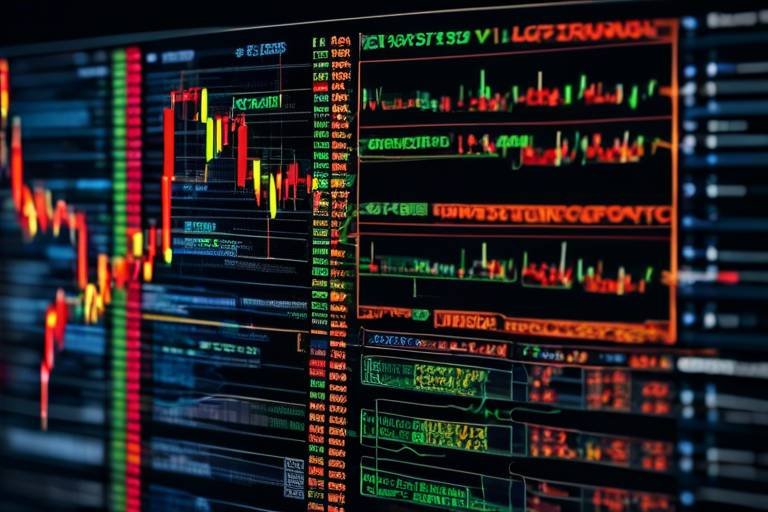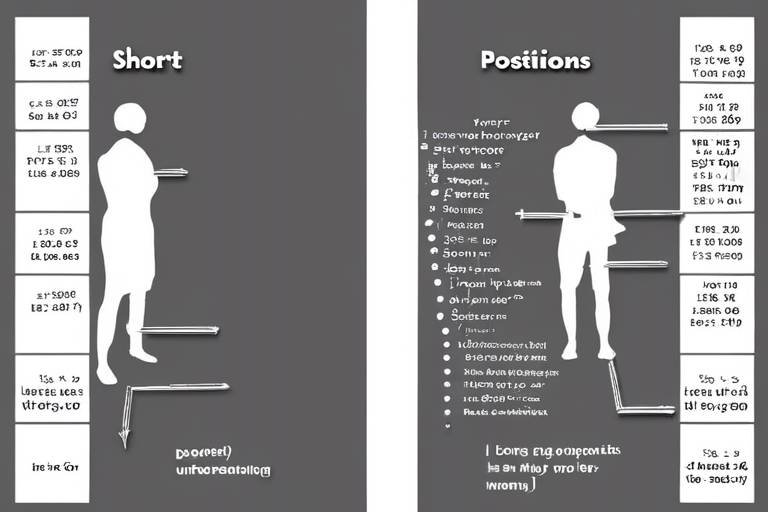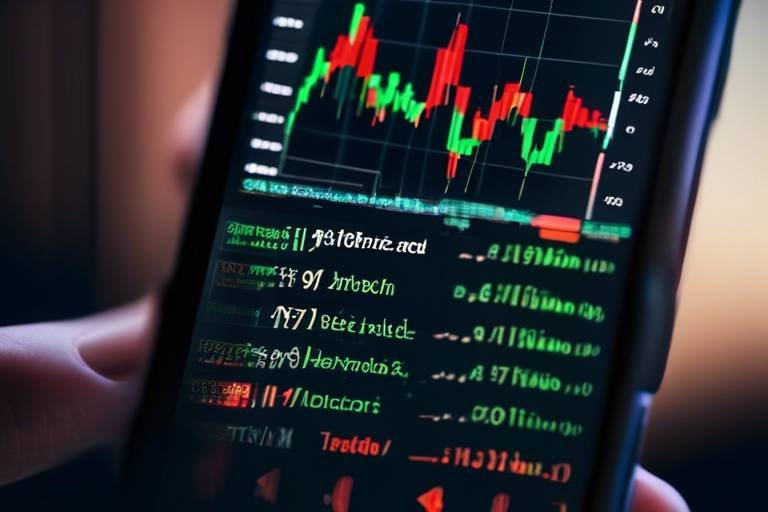How to Use Correlation Analysis in Crypto Trading
In the fast-paced world of cryptocurrency trading, making informed decisions can feel like navigating a maze. One of the most powerful tools at a trader's disposal is correlation analysis. This technique allows traders to understand the relationships between different crypto assets, enabling them to make strategic decisions based on how these assets move in relation to one another. Imagine having the ability to predict market movements by simply observing the behavior of other cryptocurrencies—this is the essence of correlation analysis.
At its core, correlation is a statistical measure that indicates how two assets move together. In the context of crypto, understanding correlation is crucial because it helps traders optimize their strategies. For instance, if two cryptocurrencies consistently move in tandem, a trader can leverage this information to anticipate price movements and adjust their trades accordingly. In a market as volatile as crypto, where prices can swing wildly, having this insight can be the difference between a profitable trade and a significant loss.
Correlation can be categorized into three main types: positive correlation, negative correlation, and zero correlation. Each type offers unique insights that can shape trading strategies and risk management approaches. Understanding these distinctions is vital for traders aiming to enhance their portfolios and navigate the complexities of the crypto market.
A positive correlation occurs when two assets move in the same direction. This means that if one asset increases in value, the other is likely to follow suit. Recognizing this can be incredibly beneficial for traders looking to diversify their portfolios while still managing risk. For example, if Bitcoin and Ethereum often exhibit a positive correlation, a trader might choose to invest in both, knowing that their values are likely to rise together.
Identifying pairs of cryptocurrencies with a strong positive correlation can significantly enhance trading strategies. Some common examples include:
- Bitcoin (BTC) and Ethereum (ETH): These two giants often react similarly to market trends and news, making them a reliable pair for correlation analysis.
- Litecoin (LTC) and Bitcoin Cash (BCH): Both assets typically follow Bitcoin's price movements, providing traders with additional opportunities.
Utilizing positive correlation in trading strategies allows traders to create a balanced portfolio. By investing in assets that move together, traders can minimize risks while maximizing potential returns. For instance, if a trader believes that Bitcoin will rise, they might also invest in Ethereum to capitalize on the expected movement, effectively hedging their bets.
On the flip side, negative correlation occurs when two assets move in opposite directions. This relationship can be particularly advantageous for hedging strategies. For example, if a trader holds Bitcoin and anticipates a price drop, they could invest in a negatively correlated asset, such as a stablecoin, to offset potential losses. This strategy can help maintain a trader's overall portfolio value even during downturns in the market.
The correlation coefficient is a numerical value that quantifies the degree of correlation between two assets. It ranges from -1 to 1, where 1 indicates a perfect positive correlation, -1 indicates a perfect negative correlation, and 0 indicates no correlation at all. Traders can use various statistical tools to calculate these coefficients, which can greatly aid in the analysis of potential trading pairs.
Excel is a powerful tool for traders looking to calculate correlation coefficients quickly. With built-in functions, traders can easily input price data for different cryptocurrencies and generate correlation coefficients in a matter of moments. This functionality allows traders to focus more on strategy and less on tedious calculations.
Understanding the value of the correlation coefficient is essential for effective trading. Values closer to 1 or -1 indicate strong relationships, while values near 0 suggest weak or no correlation. Traders should aim to identify pairs with strong correlations to inform their trading decisions, but they must also be cautious of relying solely on these values without considering other market factors.
Traders can apply correlation analysis to refine their strategies, enhance portfolio diversification, and improve risk management. By understanding how different assets interact, traders can make more informed decisions that align with their trading goals.
By analyzing correlations, traders can effectively diversify their portfolios. Investing in negatively correlated assets can reduce overall portfolio risk while maintaining profit potential. For instance, a well-diversified portfolio might include a mix of positively and negatively correlated assets, allowing traders to navigate market fluctuations with greater ease.
Correlation analysis plays a crucial role in developing risk management strategies. By identifying potential risks through correlation metrics, traders can create plans to mitigate losses in volatile markets. This proactive approach can help traders protect their investments and maintain a healthy portfolio.
While correlation analysis is a valuable tool, it is not without its limitations. Misinterpretation of correlation results can lead to poor trading decisions, making it essential for traders to understand these limitations fully.
One significant limitation is the overreliance on historical correlations. Just because two assets have moved together in the past does not guarantee they will do so in the future. Traders should exercise caution and consider current market conditions before making decisions based solely on past data.
Additionally, external factors such as regulatory changes or shifts in market sentiment can impact correlations. Traders must remain vigilant and consider these dynamics when analyzing correlations to avoid misleading conclusions. The crypto market is influenced by a myriad of factors, and understanding these can help traders make more informed choices.
1. What is correlation analysis in crypto trading?
Correlation analysis is a statistical method used to determine the relationship between two or more cryptocurrencies, helping traders predict price movements based on how these assets interact.
2. Why is understanding correlation important for traders?
Understanding correlation helps traders optimize their strategies, manage risks, and diversify their portfolios, ultimately leading to more informed trading decisions.
3. How can I calculate correlation coefficients?
Correlation coefficients can be calculated using statistical tools or software like Excel, which offers built-in functions for quickly assessing relationships between different cryptocurrencies.
4. What are the limitations of correlation analysis?
Limitations include the potential for misinterpretation of results, overreliance on historical data, and the influence of external market factors that can affect correlations.

Understanding Correlation in Crypto
Correlation is a concept that plays a pivotal role in the world of cryptocurrency trading. At its core, correlation measures the relationship between two assets, indicating how they move in relation to each other. Think of it as a dance between two partners; when one moves left, the other might follow suit or take a step in the opposite direction. This relationship is quantified using the correlation coefficient, which ranges from -1 to +1. A positive correlation (close to +1) means that the assets move in the same direction, while a negative correlation (close to -1) indicates they move in opposite directions. A coefficient near 0 suggests little to no relationship between the assets.
Understanding correlation is crucial for traders looking to optimize their strategies. Imagine you're on a boat in the middle of the ocean, trying to navigate through waves. Knowing how different assets react to market movements is like having a compass; it helps you steer clear of potential pitfalls. For instance, if Bitcoin and Ethereum are positively correlated, a trader can anticipate that if Bitcoin rises, Ethereum might follow, allowing for strategic buying or selling decisions. Conversely, if two assets are negatively correlated, a trader can hedge their bets, balancing potential losses in one asset with gains in another.
To illustrate the importance of correlation, consider the following table that summarizes the types of correlations:
| Type of Correlation | Description | Implication for Traders |
|---|---|---|
| Positive Correlation | Assets move in the same direction | Opportunity for diversification |
| Negative Correlation | Assets move in opposite directions | Hedging strategies |
| Zero Correlation | No relationship between assets | Independent asset movement |
As traders dive deeper into the crypto market, understanding correlation becomes a vital tool in their arsenal. It allows them to make informed decisions, mitigate risks, and enhance their overall trading strategies. So, the next time you analyze your crypto portfolio, remember that correlation is not just a statistic; it's a key to unlocking potential opportunities and navigating the often turbulent waters of cryptocurrency trading.
- What is correlation analysis in crypto trading? Correlation analysis helps traders understand how different cryptocurrencies move in relation to each other, aiding in decision-making.
- Why is correlation important for traders? It allows traders to optimize their portfolios, minimize risks, and enhance potential returns by understanding asset relationships.
- Can correlation change over time? Yes, correlations can fluctuate due to market dynamics, external factors, and changes in investor sentiment.
- How can I calculate correlation coefficients? Traders can use statistical tools or software like Excel to calculate correlation coefficients based on historical price data.

Types of Correlation
When diving into the world of cryptocurrency trading, understanding the is essential for making informed decisions. Correlation, in a nutshell, measures how two assets move in relation to each other. This can significantly impact trading strategies and risk management, especially in the volatile crypto market. There are three main types of correlation that traders should be aware of: positive correlation, negative correlation, and zero correlation.
A positive correlation indicates that two assets tend to move in the same direction. For instance, when the price of Bitcoin rises, the price of Ethereum often follows suit. This relationship can be beneficial for traders looking to diversify their portfolios while still capitalizing on similar market movements. By investing in assets that exhibit a positive correlation, traders can potentially maximize their returns while minimizing risks associated with individual asset volatility.
On the flip side, negative correlation occurs when two assets move in opposite directions. This can be incredibly advantageous for hedging strategies. For example, if a trader holds Bitcoin and notices a downturn in its price, they might find that a negatively correlated asset, like a stablecoin or another cryptocurrency, is performing well. This inverse relationship allows traders to offset potential losses in one asset with gains in another, providing a safety net in turbulent market conditions.
Lastly, we have zero correlation, which signifies that the price movements of two assets are completely independent of each other. This means that the performance of one asset does not affect the other in any way. While zero correlation might seem less appealing, it can still play a crucial role in a well-rounded trading strategy. By including assets with zero correlation in a portfolio, traders can reduce overall risk, as the performance of one asset will not impact the others.
To summarize, understanding these types of correlation is vital for traders aiming to optimize their strategies in the crypto market. By recognizing how assets interact, traders can make more informed decisions, whether they are looking to diversify their portfolios, hedge against losses, or simply understand market dynamics better.
| Type of Correlation | Definition | Implications for Trading |
|---|---|---|
| Positive Correlation | Assets move in the same direction. | Opportunities for diversification; potential for maximizing returns. |
| Negative Correlation | Assets move in opposite directions. | Useful for hedging strategies; offsetting losses. |
| Zero Correlation | No relationship between asset movements. | Reduces overall portfolio risk; independence of asset performance. |

Positive Correlation
A is a fascinating concept in the world of trading, especially when it comes to cryptocurrencies. It essentially means that two assets move in the same direction. If one asset's price goes up, the other tends to follow suit. This relationship can be incredibly beneficial for traders looking to optimize their strategies. Imagine you're sailing a boat; if the wind is blowing in the same direction as your intended path, your journey becomes smoother and faster. Similarly, understanding positive correlations can help traders navigate the often tumultuous waters of the crypto market.
For instance, consider the relationship between Bitcoin and Ethereum. These two cryptocurrencies often exhibit a strong positive correlation. When Bitcoin experiences a price surge due to positive market sentiment or favorable news, Ethereum typically reacts in a similar manner. This behavior can be attributed to several factors, including shared market dynamics and investor sentiment. By recognizing these correlations, traders can make informed decisions about when to buy or sell their assets.
Utilizing positive correlation can also aid in portfolio diversification. By investing in assets that are positively correlated, traders can create a balanced portfolio that minimizes risks while maximizing potential returns. For example, if you have a portfolio that includes both Bitcoin and Ethereum, the price movements of these cryptocurrencies can help to stabilize your overall investment. However, it's essential to keep in mind that while positive correlations can provide some level of security, they can also amplify risks during market downturns.
To illustrate the impact of positive correlation, let’s take a look at a simple table that highlights the correlation coefficients of various cryptocurrency pairs:
| Cryptocurrency Pair | Correlation Coefficient |
|---|---|
| Bitcoin & Ethereum | 0.85 |
| Litecoin & Bitcoin | 0.75 |
| Ripple & Stellar | 0.65 |
This table showcases how closely related these cryptocurrencies are. A correlation coefficient closer to 1 indicates a stronger positive correlation. By understanding these relationships, traders can strategize their investments more effectively. For example, if Bitcoin is expected to rise based on market trends, traders might also consider increasing their positions in Ethereum, anticipating a similar upward movement.
In conclusion, recognizing and leveraging positive correlations in crypto trading can be a game-changer. It allows traders to make more informed decisions, create better-diversified portfolios, and ultimately enhance their trading strategies. However, while it's a powerful tool, it's essential to combine correlation analysis with other trading indicators and market research to ensure a well-rounded approach to trading.
- What is correlation analysis? Correlation analysis measures the relationship between two assets, indicating how they move in relation to each other.
- Why is positive correlation important in crypto trading? Positive correlation helps traders identify opportunities for diversification and risk management, allowing for more informed trading decisions.
- How can I calculate correlation coefficients? You can calculate correlation coefficients using statistical tools or software like Excel, which offers built-in functions for this purpose.
- Can correlations change over time? Yes, correlations can change due to market dynamics, external factors, and shifts in investor sentiment.

Examples of Positive Correlation
When diving into the world of cryptocurrency, recognizing positive correlation between assets can be a game changer for traders. A prime example is the relationship between Bitcoin and Ethereum. These two giants often move in tandem, reacting similarly to market trends and external news. For instance, when Bitcoin experiences a price surge due to positive regulatory news, Ethereum often follows suit, reflecting the bullish sentiment across the crypto market.
Another noteworthy pair that exhibits a strong positive correlation is Litecoin and Bitcoin Cash. Both of these cryptocurrencies share similar technological foundations and market behaviors, which can provide traders with opportunities to capitalize on their movements. When Bitcoin's price fluctuates, it is not uncommon to see Litecoin and Bitcoin Cash respond in a similar fashion, making them attractive assets for traders looking to leverage these correlations.
To illustrate this further, let’s take a look at a simple table that outlines the correlation coefficients between some popular cryptocurrency pairs:
| Cryptocurrency Pair | Correlation Coefficient |
|---|---|
| Bitcoin & Ethereum | 0.85 |
| Litecoin & Bitcoin Cash | 0.78 |
| Ripple & Stellar | 0.65 |
This table demonstrates how closely these pairs move together, with values closer to 1 indicating a strong positive correlation. Traders can utilize this information to make informed decisions about which assets to include in their portfolios. By investing in assets that are positively correlated, traders can potentially enhance their returns during bullish market conditions while also understanding the risks involved.
In summary, recognizing positive correlation among cryptocurrencies like Bitcoin, Ethereum, Litecoin, and Bitcoin Cash can significantly enhance trading strategies. By leveraging these relationships, traders can not only optimize their portfolios but also navigate the volatile crypto landscape with greater confidence.
- What is correlation analysis in crypto trading? Correlation analysis involves examining the relationship between different cryptocurrencies to understand how they move in relation to one another, which can aid in making informed trading decisions.
- How can I calculate the correlation coefficient? You can calculate the correlation coefficient using statistical tools or software like Excel, which has built-in functions to simplify the process.
- Is positive correlation always beneficial? While positive correlation can help in creating a balanced portfolio, it also means that if one asset declines, the other may too, leading to potential losses.

Impact on Trading Strategies
Understanding the impact of positive correlation on trading strategies is vital for any cryptocurrency trader looking to optimize their portfolio. When two assets move in the same direction, it opens up a world of opportunities for traders to maximize their returns while minimizing risks. For instance, if Bitcoin and Ethereum are positively correlated, a trader might choose to invest in both, anticipating that when one rises, the other will likely follow suit. This strategy can be particularly effective in a volatile market, where price swings can be both sudden and dramatic.
Moreover, the concept of diversification comes into play here. By investing in positively correlated assets, traders can create a balanced portfolio that cushions against market shocks. However, it’s essential to strike a balance; overexposure to correlated assets can lead to significant losses if the market takes a downturn. Therefore, it's crucial to analyze not just correlations, but also the underlying factors that drive these relationships.
To illustrate, consider the following table which highlights some major cryptocurrencies and their correlations:
| Cryptocurrency Pair | Correlation Coefficient |
|---|---|
| Bitcoin & Ethereum | 0.85 |
| Litecoin & Bitcoin Cash | 0.75 |
| Ripple & Stellar | 0.60 |
This table shows that Bitcoin and Ethereum have a strong positive correlation (0.85), meaning that their prices tend to move together. Traders can leverage this information to make strategic decisions, such as pairing these assets in a single trade to capitalize on their synchronized movements.
On the flip side, while positive correlations can enhance returns, they also come with their own set of challenges. Traders must remain vigilant and continuously monitor market trends and news that could influence these correlations. For example, a significant regulatory announcement affecting Bitcoin could also impact Ethereum, leading to unexpected downturns. Thus, a proactive approach is essential in managing a portfolio that relies on correlated assets.
In conclusion, the impact of positive correlation on trading strategies is profound. By understanding how assets relate to one another, traders can make informed decisions that enhance their potential for profit while effectively managing risk. The key lies in balancing the benefits of correlation with the inherent risks of overexposure to correlated assets.
- What is correlation analysis? Correlation analysis is a statistical method used to measure the relationship between two or more assets, indicating how they move in relation to each other.
- How can I calculate correlation coefficients? You can calculate correlation coefficients using statistical tools or software like Excel, which offers built-in functions for this purpose.
- What does a correlation coefficient of 1 mean? A correlation coefficient of 1 indicates a perfect positive correlation, meaning the assets move in the same direction at all times.
- How can correlation analysis help in risk management? By identifying correlations, traders can develop strategies to hedge against potential losses, thus enhancing their risk management practices.

Negative Correlation
Negative correlation is a fascinating concept in the realm of cryptocurrency trading. It occurs when two assets move in opposite directions; when one goes up, the other tends to go down. This relationship can be incredibly advantageous for traders looking to hedge their positions and manage risk effectively. Imagine you’re walking a tightrope; having a safety net below you is crucial. In trading, negatively correlated assets serve as that safety net, cushioning potential falls in your portfolio.
For instance, consider a scenario where you hold Bitcoin, which is experiencing a bullish trend. If you also invest in a cryptocurrency that has a negative correlation with Bitcoin, such as certain stablecoins or other altcoins, you can potentially offset losses if Bitcoin's price suddenly drops. This strategy allows traders to maintain a balanced portfolio while navigating the volatile waters of the crypto market.
To illustrate this further, let’s look at a simple table that highlights some examples of negatively correlated assets:
| Asset 1 | Asset 2 | Correlation Coefficient |
|---|---|---|
| Bitcoin (BTC) | Gold (XAU) | -0.3 |
| Ethereum (ETH) | US Dollar (USD) | -0.5 |
| Litecoin (LTC) | Inverse Bitcoin ETF | -0.8 |
As you can see from the table, a negative correlation coefficient indicates a strong inverse relationship between the assets listed. This means that when the price of Bitcoin rises, the price of gold tends to fall, and vice versa. By incorporating these negatively correlated assets into your trading strategy, you can create a buffer against market volatility.
However, it’s essential to remember that while negative correlation can provide a safety net, it does not guarantee profits. Market dynamics are influenced by various external factors, such as regulatory changes, market sentiment, and macroeconomic trends. Therefore, a thorough analysis of these factors is crucial before making trading decisions based on correlation.
In conclusion, understanding negative correlation can be a game-changer for traders. It allows for strategic positioning in the market, helping to mitigate risks while still seeking opportunities for profit. By carefully analyzing and selecting negatively correlated assets, traders can enhance their overall trading strategies and navigate the unpredictable world of cryptocurrency trading with greater confidence.
- What is correlation analysis in crypto trading? Correlation analysis is a statistical method used to determine the relationship between two or more assets, helping traders understand how they move in relation to one another.
- How can negative correlation benefit my trading strategy? Negative correlation allows traders to hedge their positions, reducing overall portfolio risk by investing in assets that move in opposite directions.
- Can correlation change over time? Yes, correlations can fluctuate due to market dynamics, external factors, and changes in investor sentiment, so it's essential to regularly analyze them.
- Is a negative correlation always a good sign? Not necessarily. While it can be beneficial for risk management, traders should also consider other factors, such as market conditions and the specific assets involved.

Calculating Correlation Coefficients
When it comes to crypto trading, understanding how to calculate correlation coefficients is like having a secret weapon in your trading arsenal. These coefficients provide a numerical value that quantifies the degree of correlation between two assets, giving traders a clearer picture of how these assets interact with each other. But how exactly do you go about calculating these coefficients?
The correlation coefficient ranges from -1 to 1. A coefficient of 1 indicates a perfect positive correlation, meaning that as one asset moves, the other moves in the same direction by the same proportion. Conversely, a coefficient of -1 signifies a perfect negative correlation, where one asset moves in the opposite direction of the other. A coefficient of 0 implies no correlation, indicating that the movements of the two assets are completely independent of each other. This understanding is crucial for traders aiming to optimize their strategies.
To calculate the correlation coefficient, traders often utilize statistical tools or software. One of the most accessible tools for this purpose is Excel, which offers built-in functions that simplify the process. By inputting historical price data of the cryptocurrencies you are interested in, you can quickly compute the correlation coefficient. Here’s a simple breakdown of the steps:
- Gather Data: Collect historical price data for the two cryptocurrencies you want to analyze. This data can often be sourced from various cryptocurrency exchanges or financial data websites.
- Input Data: Open Excel and input the price data into two separate columns.
- Use the CORREL Function: In a new cell, type the formula
CORREL(array1, array2), wherearray1andarray2are the ranges of your two data sets. - Analyze Results: Press Enter, and Excel will return the correlation coefficient for your selected data.
For those who prefer a visual representation, here’s a simple table illustrating how correlation coefficients can be interpreted:
| Coefficient Value | Interpretation |
|---|---|
| 1 | Perfect positive correlation |
| 0.5 to 0.99 | Strong positive correlation |
| 0 to 0.49 | Weak positive correlation |
| 0 | No correlation |
| -0.49 to 0 | Weak negative correlation |
| -0.99 to -0.5 | Strong negative correlation |
| -1 | Perfect negative correlation |
Understanding these coefficients and how to calculate them is essential for any trader looking to make informed decisions in the crypto market. By analyzing the correlation between different cryptocurrencies, traders can better predict price movements and adjust their strategies accordingly. However, it's important to remember that correlation does not imply causation; just because two assets move together does not mean one causes the other to move. Always consider the broader market context and external factors that may influence these relationships.
What is a correlation coefficient?
A correlation coefficient is a statistical measure that describes the strength and direction of a relationship between two variables. In crypto trading, it helps traders understand how different cryptocurrencies move in relation to each other.
How can I use correlation coefficients in my trading strategy?
By analyzing correlation coefficients, traders can identify pairs of cryptocurrencies that move together or in opposite directions, allowing for better portfolio diversification and risk management.
Can correlation analysis predict future price movements?
While correlation analysis can provide insights into how assets have moved together in the past, it does not guarantee future movements. Traders should consider other factors and market dynamics.
Is Excel the best tool for calculating correlation coefficients?
Excel is a popular and user-friendly tool for calculating correlation coefficients, but there are other statistical software options available that can also perform this analysis effectively.

Using Excel for Calculation
When it comes to analyzing correlations in cryptocurrency trading, Excel is a powerful tool that can simplify the process significantly. Many traders may not realize just how versatile this software can be, especially when it comes to calculating correlation coefficients between various cryptocurrencies. By using Excel, traders can easily input their data and leverage built-in functions to generate insightful analyses without the need for complex programming or advanced statistical software.
To get started with correlation analysis in Excel, the first step is to gather historical price data for the cryptocurrencies you want to analyze. This data can typically be sourced from various cryptocurrency exchanges or financial websites. Once you have your data in hand, you can organize it in an Excel spreadsheet. A simple layout could involve placing the dates in one column and the corresponding prices of the cryptocurrencies in adjacent columns. For instance:
| Date | Bitcoin Price | Ethereum Price |
|---|---|---|
| 2023-01-01 | 30000 | 2000 |
| 2023-01-02 | 31000 | 2100 |
| 2023-01-03 | 29000 | 1900 |
Once your data is organized, calculating the correlation coefficient is straightforward. You can use the CORREL function in Excel, which is designed specifically for this purpose. The syntax for the function is as follows:
CORREL(array1, array2)
Here, array1 would be the range of cells containing the prices of the first cryptocurrency (e.g., Bitcoin), and array2 would be the range for the second cryptocurrency (e.g., Ethereum). By applying this function, Excel will return a value between -1 and 1, indicating the strength and direction of the correlation.
For example, if you input the following formula:
CORREL(B2:B4, C2:C4)
This would calculate the correlation coefficient between Bitcoin and Ethereum based on the data provided in the table above. The result will help you understand how closely the prices of these two cryptocurrencies move in relation to each other. A value close to 1 means they move together, while a value closer to -1 indicates they move in opposite directions.
Using Excel not only streamlines the process of correlation analysis but also allows traders to visualize the data through charts and graphs. This visual representation can further enhance understanding and decision-making. So, if you haven’t already, it’s time to embrace Excel as your ally in the world of crypto trading!
- What is correlation analysis? Correlation analysis is a statistical method used to measure the relationship between two assets, indicating how they move in relation to each other.
- Why is correlation important in crypto trading? Understanding correlation helps traders optimize their strategies, manage risks, and make informed decisions based on how different assets behave in relation to one another.
- Can correlation change over time? Yes, market dynamics, external factors, and changes in sentiment can impact correlations, making continuous analysis essential.

Interpreting Correlation Coefficients
Understanding the value of the correlation coefficient is crucial for any trader looking to leverage correlation analysis in their strategies. This coefficient, which ranges from -1 to 1, provides valuable insights into how two assets move in relation to each other. A coefficient of 1 indicates a perfect positive correlation, meaning that as one asset increases in value, the other does too, in perfect sync. Conversely, a coefficient of -1 signifies a perfect negative correlation, where one asset’s increase corresponds with the other’s decrease. Finally, a coefficient close to 0 suggests that there is little to no correlation between the two assets, indicating that their price movements are independent.
To put this into perspective, consider the following scale for interpreting correlation coefficients:
| Correlation Coefficient | Interpretation |
|---|---|
| 1.0 | Perfect Positive Correlation |
| 0.5 - 0.9 | Strong Positive Correlation |
| 0.1 - 0.4 | Weak Positive Correlation |
| 0 | No Correlation |
| -0.1 - -0.4 | Weak Negative Correlation |
| -0.5 - -0.9 | Strong Negative Correlation |
| -1.0 | Perfect Negative Correlation |
When traders analyze these coefficients, they can make more informed decisions. For instance, if a trader notices that Bitcoin (BTC) and Ethereum (ETH) have a correlation coefficient of 0.8, they can infer that these two cryptocurrencies tend to move together. This information can be pivotal when deciding how to allocate assets within a portfolio. On the other hand, if they find that BTC and a lesser-known altcoin have a correlation coefficient of -0.7, this could indicate a potential hedge opportunity, allowing the trader to protect their investments against market volatility.
It's important to remember that while correlation coefficients provide valuable insights, they should not be the sole basis for trading decisions. Market conditions, external factors, and news events can all influence asset prices in ways that correlation alone cannot predict. Thus, traders should use correlation analysis as one tool among many in their trading toolkit, ensuring a comprehensive approach to market analysis.
- What is a correlation coefficient? A correlation coefficient quantifies the degree to which two assets move together, ranging from -1 to 1.
- How can I calculate the correlation coefficient? You can use statistical tools or software like Excel to calculate the correlation coefficient based on historical price data.
- Why is correlation analysis important in crypto trading? It helps traders identify relationships between assets, allowing for better portfolio diversification and risk management.
- Can correlation coefficients change over time? Yes, correlation can vary due to market dynamics and external factors, so it's essential to regularly reassess them.

Applying Correlation Analysis in Trading
Correlation analysis is not just a theoretical concept; it’s a powerful tool that can significantly enhance your trading strategies in the unpredictable world of cryptocurrency. By understanding how different assets interact with one another, traders can make more informed decisions, ultimately leading to better outcomes. Imagine you're at a concert—if the guitar player plays a solo, the drummer might change their tempo to match. Similarly, in trading, the movements of one cryptocurrency can influence another, and recognizing these patterns can be your ticket to smarter trading.
One of the primary applications of correlation analysis is in portfolio diversification. By analyzing the correlations between various cryptocurrencies, traders can build a portfolio that minimizes risk without sacrificing potential profits. For example, if you invest in two cryptocurrencies that are negatively correlated, when one asset's price drops, the other may rise, thereby balancing your overall portfolio performance. This dynamic can be particularly beneficial in the volatile crypto market, where drastic price movements are common.
Moreover, correlation analysis plays a crucial role in developing risk management strategies. By identifying which assets are likely to move together or in opposition, traders can create a more robust plan to mitigate losses. For instance, if you notice that Bitcoin and a specific altcoin frequently move in opposite directions, you can strategically allocate your investments to hedge against potential downturns in the market. This proactive approach not only helps protect your capital but also enhances your ability to capitalize on market fluctuations.
To illustrate the impact of correlation analysis in trading, consider the following
| Cryptocurrency Pair | Correlation Coefficient | Implication |
|---|---|---|
| Bitcoin & Ethereum | 0.85 | Strong Positive Correlation |
| Bitcoin & Litecoin | -0.45 | Moderate Negative Correlation |
| Ripple & Stellar | 0.10 | Weak Correlation |
In this table, you can see how different cryptocurrency pairs exhibit varying levels of correlation. A strong positive correlation between Bitcoin and Ethereum suggests that these two assets often move together, which might encourage traders to consider them as a pair in their trading strategies. On the other hand, the moderate negative correlation between Bitcoin and Litecoin indicates that these two may serve as effective hedges against each other. Understanding these relationships can empower traders to make smarter, data-driven decisions.
Ultimately, applying correlation analysis in trading is about being strategic and informed. It’s not just about picking random assets; it's about understanding the interconnectedness of the market. By leveraging correlation analysis, traders can refine their strategies, improve risk management, and enhance portfolio diversification. So, the next time you’re considering your trades, ask yourself: how do these assets relate to one another? The answer could very well shape your trading success.
- What is correlation analysis? Correlation analysis measures the relationship between two assets, indicating how they move in relation to each other.
- Why is correlation important in crypto trading? Understanding correlations helps traders optimize their strategies, manage risks, and diversify their portfolios effectively.
- How can I calculate correlation coefficients? Traders can use statistical tools or software like Excel to calculate correlation coefficients based on historical price data.
- What are the limitations of correlation analysis? Correlation analysis can be misleading if traders rely solely on historical data or fail to consider external market factors.

Portfolio Diversification
In the unpredictable world of cryptocurrency trading, stands as a crucial strategy that can significantly mitigate risks while maximizing potential returns. By spreading investments across various assets, traders can protect themselves from the volatility that often plagues the crypto market. Think of it as not putting all your eggs in one basket; if one asset falters, others may thrive, providing a buffer against losses. This is particularly important in the crypto space, where market sentiment can shift rapidly due to numerous factors, including regulatory news or technological advancements.
To effectively diversify a portfolio, traders should consider the correlation between different cryptocurrencies. By investing in assets that exhibit negative correlation, traders can create a safety net. For instance, if Bitcoin experiences a downturn, a negatively correlated asset like certain altcoins may rise, helping to offset potential losses. Conversely, investing in assets with a positive correlation can enhance returns when the market is bullish, as these assets are likely to move in tandem.
To illustrate this concept, let's look at a simple table that outlines potential cryptocurrency pairs and their correlation types:
| Cryptocurrency Pair | Correlation Type |
|---|---|
| Bitcoin & Ethereum | Positive |
| Bitcoin & Ripple | Negative |
| Litecoin & Ethereum | Positive |
| Bitcoin Cash & Litecoin | Positive |
| Ethereum Classic & Bitcoin | Negative |
By analyzing these correlations, traders can make informed decisions about which cryptocurrencies to include in their portfolios. Diversification doesn't just reduce risk; it also opens up opportunities for profit. For example, if a trader holds a mix of positively correlated assets and a few negatively correlated ones, they can enjoy the benefits of market rallies while protecting themselves during downturns.
Ultimately, the goal of diversification is to create a balanced portfolio that aligns with your risk tolerance and investment goals. It’s not just about having multiple assets; it’s about strategically selecting those assets based on their correlations. This approach can lead to a more resilient portfolio, capable of weathering the storm in the ever-evolving crypto landscape.
- What is portfolio diversification?
Portfolio diversification is the practice of spreading investments across various assets to reduce risk and enhance returns.
- Why is correlation important in diversification?
Correlation helps traders understand how different assets move in relation to one another, allowing for better risk management and strategic investment choices.
- Can I diversify my portfolio with just cryptocurrencies?
Yes, you can diversify within the crypto market by investing in various cryptocurrencies that have different correlation profiles.
- How often should I review my portfolio?
Regular reviews are essential, especially in the volatile crypto market. It's advisable to reassess your portfolio at least quarterly or after significant market events.

Risk Management Strategies
In the unpredictable world of cryptocurrency trading, having robust is not just a luxury—it's a necessity. The volatile nature of crypto markets can lead to significant gains, but it can also result in devastating losses if traders are not prepared. By employing correlation analysis, traders can develop strategies that help mitigate risks effectively. One of the primary advantages of understanding correlations is the ability to create a diversified portfolio that can withstand market fluctuations.
For instance, by investing in assets that exhibit negative correlation, traders can hedge against potential losses. If one asset declines in value, the other is likely to increase, thus offsetting losses. This strategy not only protects capital but also allows traders to maintain exposure to the market without putting their entire portfolio at risk. Imagine a seesaw: when one side goes down, the other goes up. In the same way, negatively correlated assets can balance each other out, providing a more stable trading experience.
Moreover, correlation analysis can also assist in identifying high-risk assets. By analyzing the correlation coefficients, traders can pinpoint which assets are more volatile and which ones tend to stabilize their portfolios. For example, if a trader notices that a particular cryptocurrency is highly correlated with a stable coin, they might decide to allocate a larger portion of their investment to the stable coin to minimize exposure to risk. This approach is akin to having a safety net; it provides a cushion that can absorb the shocks of sudden market movements.
Additionally, it's crucial to regularly review and adjust your portfolio based on the latest correlation data. Market dynamics can change rapidly, and what worked yesterday may not work today. By staying informed and adaptable, traders can reposition their assets to maintain a balanced risk profile. This proactive approach is essential in the fast-paced world of crypto trading, where the only constant is change.
Ultimately, the key to successful risk management lies in understanding that correlation is not just a static number; it's a dynamic tool that, when used correctly, can lead to informed trading decisions. By leveraging correlation analysis, traders can not only protect their investments but also enhance their potential for profit. It's all about playing smart, staying informed, and being ready to pivot when necessary.
- What is correlation analysis in crypto trading?
Correlation analysis measures the relationship between different cryptocurrencies, helping traders understand how they move in relation to one another. - How can I calculate correlation coefficients?
You can calculate correlation coefficients using statistical tools or software like Excel, which has built-in functions for this purpose. - What are the limitations of correlation analysis?
Correlation analysis can be misleading if traders over-rely on historical data or fail to consider external market factors. - How can I use correlation analysis for risk management?
By identifying negatively correlated assets, traders can hedge against losses and create a more balanced portfolio.

Limitations of Correlation Analysis
While correlation analysis is a powerful tool in the arsenal of crypto traders, it is not without its limitations. Understanding these limitations is crucial for making informed trading decisions. One of the primary concerns is the potential for misinterpretation of correlation results. Traders might mistakenly assume that a strong correlation between two assets guarantees that their prices will move together in the future. This is a dangerous assumption, as correlation does not imply causation. Just because two cryptocurrencies have moved in tandem in the past does not mean they will continue to do so.
Another significant limitation is the overreliance on historical data. Traders often look at past performance to predict future outcomes, but the cryptocurrency market is notoriously volatile. Factors such as sudden regulatory changes, market sentiment shifts, or technological advancements can drastically alter the relationships between assets. For example, a cryptocurrency that has shown a positive correlation with Bitcoin may suddenly diverge due to a major news event or market shift. Thus, while historical correlations can provide insights, they should not be the sole basis for trading decisions.
Furthermore, external factors can heavily influence correlations. Market dynamics, such as economic indicators, geopolitical events, and even social media sentiment, can all play a role in how cryptocurrencies interact with one another. Traders must be aware of these external influences and consider them when analyzing correlations. For instance, if a country announces strict regulations on cryptocurrency trading, it could negatively impact the correlation between that country's assets and those of others worldwide.
To illustrate these limitations, consider the following table that summarizes key points:
| Limitation | Description |
|---|---|
| Misinterpretation of Results | Strong correlation does not guarantee future price movements. |
| Overreliance on Historical Data | Past performance may not predict future outcomes due to market volatility. |
| Influence of External Factors | Market dynamics and news can significantly alter asset correlations. |
In conclusion, while correlation analysis can enhance trading strategies and risk management, it is vital for traders to approach it with a critical mindset. By understanding its limitations and considering external factors, traders can make more informed decisions and avoid the pitfalls of overconfidence in their analyses.
- What is correlation analysis? Correlation analysis measures the relationship between two assets, indicating how they move in relation to each other.
- How can I calculate correlation coefficients? You can use statistical tools, including Excel, to calculate the correlation coefficients between different cryptocurrencies.
- Why is understanding correlation important in trading? Understanding correlation helps traders optimize their strategies, manage risks, and diversify their portfolios.
- Can correlation analysis predict future price movements? Not necessarily; correlation does not imply causation, and past correlations may not hold in the future.

Overreliance on Historical Data
This article explores the significance of correlation analysis in cryptocurrency trading, providing insights on how traders can leverage correlations between different assets to make informed trading decisions.
Correlation measures the relationship between two assets, indicating how they move in relation to each other. It is crucial for traders to understand this concept to optimize their trading strategies.
There are three main types of correlation: positive, negative, and zero. Each type has distinct implications for trading strategies and risk management in the volatile crypto market.
A positive correlation implies that two assets move in the same direction. Understanding this can help traders identify opportunities for diversification and risk management within their crypto portfolios.
Identifying pairs of cryptocurrencies that exhibit positive correlation can enhance trading strategies. Examples include Bitcoin and Ethereum, which often react similarly to market trends and news.
Traders can use positive correlation to create a balanced portfolio, minimizing risks by investing in correlated assets while maximizing potential returns through strategic trades.
Negative correlation occurs when two assets move in opposite directions. This relationship can be advantageous for hedging strategies, allowing traders to offset potential losses in one asset with gains in another.
The correlation coefficient quantifies the degree of correlation between assets. Traders can use statistical tools to calculate these coefficients, aiding in the analysis of potential trading pairs.
Excel offers built-in functions to easily calculate correlation coefficients. Traders can input price data to quickly assess relationships between different cryptocurrencies.
Understanding the value of the correlation coefficient is essential. Values closer to 1 or -1 indicate strong relationships, while values near 0 suggest weak or no correlation between assets.
Traders can apply correlation analysis to refine their strategies, improve risk management, and enhance portfolio diversification. This section explores practical applications of correlation analysis in crypto trading.
By analyzing correlations, traders can diversify their portfolios effectively. Investing in negatively correlated assets can reduce overall portfolio risk while maintaining potential for profit.
Correlation analysis aids in developing risk management strategies. Traders can use it to identify potential risks and create plans to mitigate losses in volatile markets.
While correlation analysis is valuable, it has limitations. Misinterpretation of correlation results can lead to poor trading decisions, making it essential for traders to understand these limitations.
One of the significant pitfalls in using correlation analysis is the . Many traders tend to assume that past correlations will persist into the future, but this is often a risky assumption. Just like weather patterns can change unexpectedly, so can market dynamics. For instance, if Bitcoin and Ethereum have shown a strong positive correlation over the past year, traders might assume this trend will continue indefinitely. However, sudden market shifts, regulatory changes, or technological advancements can disrupt these historical relationships.
Moreover, the crypto market is notorious for its volatility. A correlation coefficient calculated from historical data may not accurately reflect current market conditions. For example, during a market crash, assets that typically move together might diverge significantly as panic selling occurs. This divergence can lead to misguided trading decisions if traders are not aware of the changing dynamics.
In summary, while historical data provides valuable insights, it should not be the sole basis for trading decisions. Traders must remain vigilant and consider current market conditions, external factors, and potential shifts in investor sentiment. By doing so, they can avoid the trap of overreliance on historical data and make more informed trading choices.
External factors, such as regulatory changes or market sentiment, can impact correlations. Traders must consider these dynamics when analyzing correlations to avoid misleading conclusions.
- What is correlation analysis in crypto trading?
Correlation analysis helps traders understand how different cryptocurrencies move in relation to each other, which can inform trading strategies. - Why is it important to consider market dynamics?
Market dynamics can significantly impact asset correlations, making it essential for traders to stay updated on news and events that could influence the market. - How can I calculate correlation coefficients?
You can calculate correlation coefficients using statistical tools or software like Excel, which has built-in functions for this purpose. - What should I do if I find strong historical correlations?
While strong historical correlations can provide insights, always consider current market conditions and potential external factors before making trading decisions.

Market Dynamics and External Factors
When diving into the world of cryptocurrency trading, it's crucial to recognize that the landscape is not static. Market dynamics and external factors play a significant role in shaping the correlations between different assets. For instance, regulatory changes can create ripples across the market, altering how assets interact with one another. Imagine a sudden announcement from a government about cryptocurrency regulations; this can lead to a rapid shift in investor sentiment, impacting the correlation between Bitcoin and altcoins.
Moreover, external factors such as technological advancements, macroeconomic trends, and even social media sentiment can influence market behavior. For example, if a new technology is introduced that enhances the functionality of a specific cryptocurrency, it might lead to increased demand for that asset, affecting its correlation with others. Similarly, a tweet from a high-profile influencer can cause a surge in trading volumes and alter the dynamics of asset relationships.
It's essential for traders to stay updated on these factors. Ignoring them can lead to misleading conclusions about correlations. Traders should not only analyze historical data but also keep an eye on current events and trends that could impact the market. This holistic approach to understanding market dynamics ensures that traders make informed decisions based on both quantitative data and qualitative insights.
In summary, while correlation analysis is a powerful tool for traders, it must be integrated with an understanding of the broader market context. By considering external factors, traders can enhance their strategies and better navigate the complexities of the cryptocurrency market.
- What is correlation analysis in crypto trading?
Correlation analysis involves examining the relationship between different cryptocurrencies to understand how they move in relation to one another.
- How can I calculate correlation coefficients?
You can calculate correlation coefficients using statistical tools or software like Excel, which provides built-in functions for this purpose.
- What are the limitations of correlation analysis?
Correlation analysis can be misleading if traders over-rely on historical data or fail to consider external market dynamics.
- How can correlation analysis improve my trading strategy?
By understanding correlations, traders can diversify their portfolios, develop risk management strategies, and make more informed trading decisions.
Frequently Asked Questions
- What is correlation analysis in crypto trading?
Correlation analysis is a statistical method used to evaluate the relationship between two or more cryptocurrency assets. It helps traders understand how these assets move in relation to each other, allowing for more informed trading decisions.
- Why is understanding correlation important for traders?
Understanding correlation is crucial for traders as it aids in optimizing trading strategies, managing risks, and diversifying portfolios. By knowing how assets correlate, traders can better predict market movements and make strategic investments.
- What are the types of correlation I should know about?
There are three main types of correlation: positive, negative, and zero. Positive correlation means assets move in the same direction, negative correlation indicates they move in opposite directions, and zero correlation suggests no relationship between the assets.
- How can I calculate correlation coefficients?
Correlation coefficients can be calculated using statistical tools or software like Excel. Traders can input price data of the cryptocurrencies to quickly assess their relationships and determine the strength of the correlation.
- What does a correlation coefficient value indicate?
A correlation coefficient value ranges from -1 to 1. Values close to 1 or -1 indicate a strong correlation, while values near 0 suggest a weak or no correlation. This helps traders understand the dynamics between different assets.
- How can I apply correlation analysis in my trading strategy?
Traders can apply correlation analysis to refine their trading strategies by diversifying their portfolios, improving risk management, and identifying potential trading pairs that can enhance returns while minimizing risks.
- What are the limitations of correlation analysis?
While correlation analysis is valuable, it has limitations. Overreliance on historical data can mislead traders, as past correlations may not predict future movements. Additionally, external factors like market sentiment can impact correlations.



















